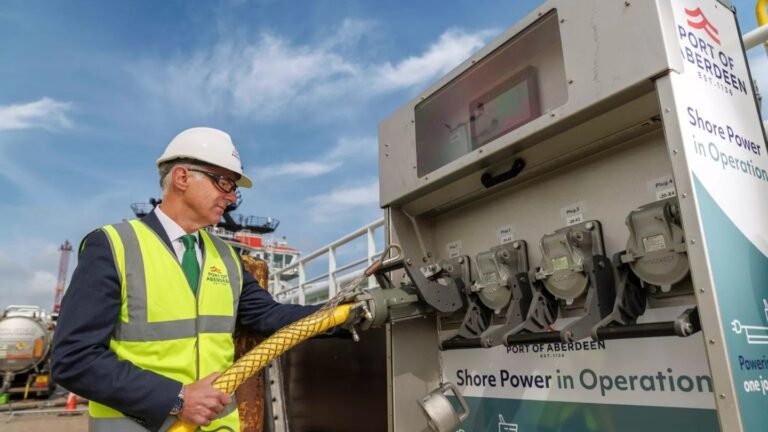A maritime decarbonisation initiative claimed to be the largest in Scotland has commenced operations at the Port of Aberdeen.
The project introduces green shore power for vessels at eight berths within the port’s North Harbour, marking a step towards becoming the UK’s first net-zero port by 2040.
The newly electrified berths are part of the Shore Power in Operation demonstrator, a project supported by the Department for Transport’s Zero Emissions, Vessels and Infrastructure competition, with a combined public-private investment of £4m ($5.3m).
Installed by shore power technology company PowerCon, the new infrastructure allows ships to connect to the port’s renewable energy tariff, reducing reliance on fossil fuels while docked.
This transition is expected to cut up to 60,000 tonnes (t) of CO₂ equivalent over two decades, equating to the emissions of approximately 2,140 cars annually, in addition to reducing noise.
The NS Iona, managed by OSM Thome, was the first vessel to utilise the new system. This ship is among five retrofitted to accept shore power as part of the initiative.
Port of Aberdeen CEO Bob Sanguinetti said: “Port of Aberdeen’s net zero journey has taken a significant step forward. Our Shore Power in Operation demonstrator is the single biggest maritime decarbonisation project in Scotland to date.
“It represents a £4m investment in clean energy and will be a game-changer for Port of Aberdeen and our valued customers, who will benefit from an 80% reduction in their carbon emissions while at berth.”
The Shore Power in Operation project is a component of the wider Zero Emissions Vessels and Infrastructure competition, which allocated more than £80m to ten flagship projects across the UK.
Port of Aberdeen spearheaded a consortium, including OSM Offshore, Tidewater Marine UK, Connected Places Catapult, and the University of Manchester’s Tyndall Centre, with additional support from Buro Happold and Energy Systems Catapult, to realise this endeavour.
Shore power infrastructure has also been installed at Regent Quay for Bibby Marine’s electric Service Operation Vessel ZEVI project and is nearing completion for Serco NorthLink’s passenger ferries funded by Caledonian Maritime Assets.
These developments contribute to the port’s existing shore power facilities, which support renewable energy customers and towage providers.
Looking ahead, the port aims to expand its shore power capabilities across its 7,600m quayside.
In July last year, the Port of Aberdeen received its largest ship to date, the Costa Faolosa cruise vessel, just a year after experiencing its most successful summer season on record.

